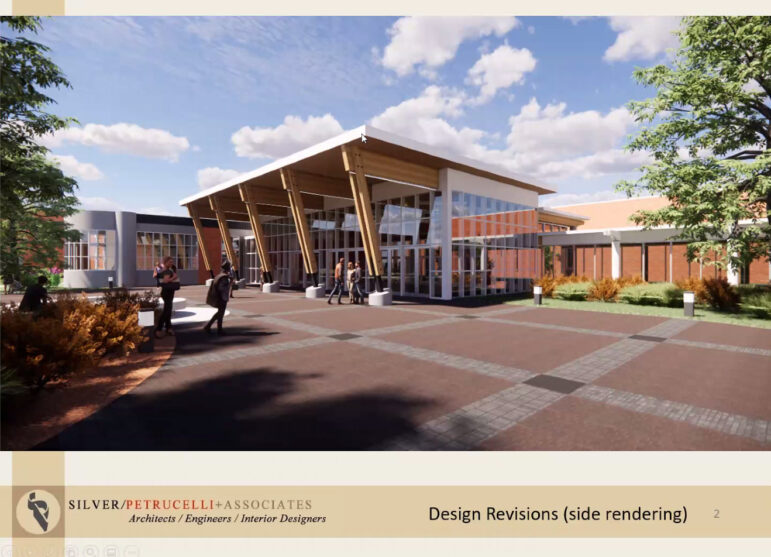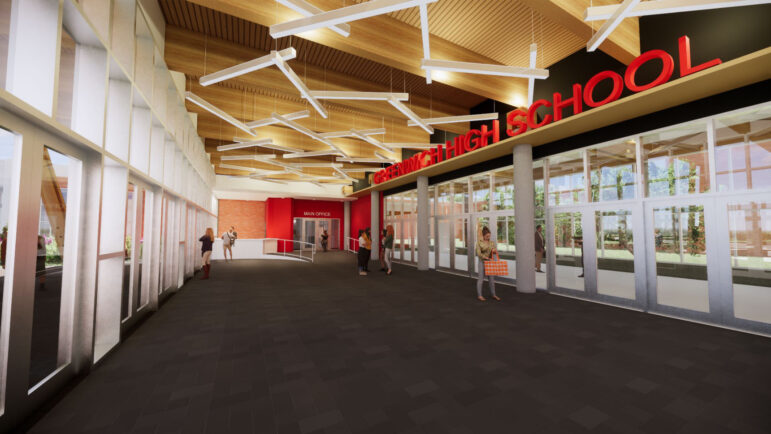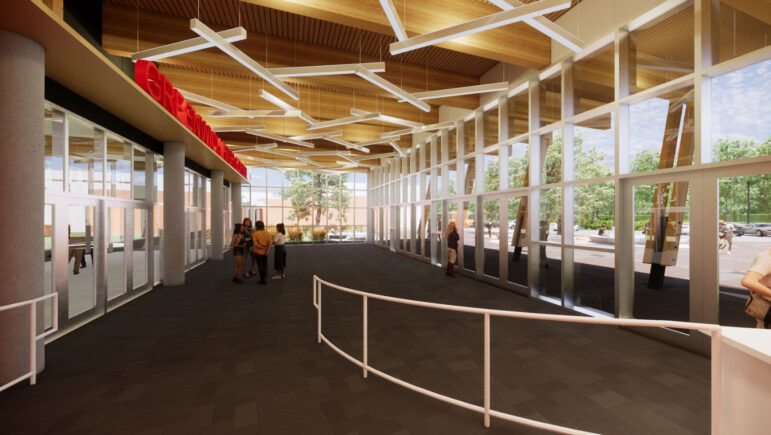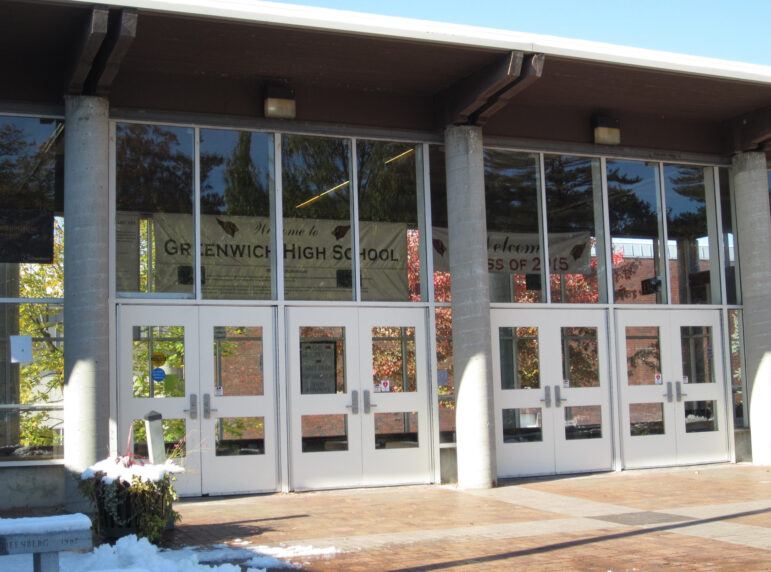A final site plan and special permit for a major redesign of the entrance of Greenwich High School was approved by the Planing and Zoning commission on Thursday night with conditions.
The commission said the building committee should work out remaining architectural details with the Architectural Review Committee, including design of fascia and plinths, as well as follow up with both full landscaping and lighting plans.
“That takes us out of the equation and saves you time,” said P&Z chair Margarita Alban.
Commission member Victoria Goss asked how the vestibule would increase security at the building.

Main entrance to GHS is (doors at left) directly into the glass corridor, which is packed with hundreds of students at passing time between classes. Visitors cross to the opposite side of the corridor to a security desk to check in.
Building committee chair Steve Walko acknowledged there are many exterior doors to the enormous building, and likely many vulnerable spots, but the number one issue for the Board of Education was the high school’s front entrance, which currently directly spills right into the glass corridor where hundreds of students pass from class to class.
The new vestibule will have blast and bullet resistant glass.
“I don’t think we’re under any illusion this glass vestibule will solve every security issue at GHS,” he said. “If you look at school shootings, they happen to be from known entities. The concept is to put your security personnel where they can visibly see students coming in, identify threats, and capture threats within this box.”
Much has changed since the building was constructed in 1970 on wetlands. The school has grown in size and had many FAR variances since its first in 1975.
And, over the years, safety has become an increasing concern. When the school originally opened in 1970, the “glass corridor” was all open, and didn’t have glass. Students had cubbies, not lockers.
Longstanding resistance among parents to detailing a police officer to the high school waned, and in 2007, the first School Resource Officer was assigned to the building. A few years ago, a second officer was added.

Rendering of safety vestibule includes wooden supports over plinths, which the commission said might be made to be more inviting to sit on. The 71 foot x 28 foot deep by 25 foot high entry hall will be appended to the existing main entry facing Hillside Road.

Rendering of proposed Greenwich High School security vestibule that would abut the existing glass corridor.

Rendering of proposed security vestibule adjacent to existing glass corridor. The security officer will have control of the single pair of exterior doors through which students and visitors will be admitted after all exterior doors are secured after student drop off.
Mr. Walko said with P&Z approval, his committee would “hit the ground running,” select a general contractor, and start construction the day after students leave in June 2022.
“The crunch time is those few months when we’re impacting the glass corridor,” Walko said. “We would then have all the work impacting the glass corridor finished before school starts, so school can still utilize the glass corridor, and then finish all work by the February 2023 break.”
Landscaping
The commission had concerns that the application was missing detailed lighting and landscaping plans, but noted the project’s tight timeline, and safety being top priority.
Ms. Alban said zoning regulations required a landscaping plan.
“If the BOE does not realize that, we probably need to communicate it clearly for the future,” she said.
“It remains a sore spot with the neighbors adjacent to the high school that, yes it was partly due to contamination, but in other areas there has not been the screening and buffering neighbors were hoping to have to shield them from the non-residential use. We are looking to further buffer residential uses from the non-residential.”
“It isn’t just, you build the bricks and walk away,” Alban said. “It puts us in an awkward situation where the only folks not complying with zoning regulations is our own town.”
P&Z director Katie DeLuca said any landscaping or digging would “potentially (be) an uphill battle with respect to how to deal with the soil.”
“As I understand it, the site before us is not on contaminated soil,” Walko said.”From DPW, the remediated areas are in other locations.”
“I don’t know that any part of Greenwich High School has totally clean (soil),” he added.
Ms Alban said checking the soil should have been “up front” in the application.
“You can move forward with building this. You’re going to have to test for contamination, work with DPW, do a design and you’re going to have to tell the BOE that we insist on landscaping. It’s part of our zoning regulations,” Alban said.
During public comment, JoAnn Messina from the Greenwich Tree Conservancy, noted that in the last decade over 800 trees had been removed from the GHS campus.
She said the GTC had already planted 12 trees in front of the building. “I believe the contamination is in the back areas. We can plant in the front. It’s worth our while to do that.”
Messina said the tree warden should be involved.

The existing glass corridor doubles as the GHS main entrance, and dates back to 1970 when the building opened.
Lighting
Mr. Walko acknowledged neighborhood complaints about campus lights being left on all night.
In the past, neighbors have described the GHS campus as an airport landing strip.
Elizabeth Dempsey who lives across the street, said at the previous night’s ARC meeting, there was talk about a commitment to creating a deadline to turn off the lights at night.
“We have been very pointed about trying to do something as well,” Alban said. “If they would address this issue of lights being on constantly at GHS and whether that is such a security need as has been represented to us. We know it disturbs the neighbors. The lighting is going to be part of our conditions.”
Ms Dempsey said for 20 years she had observed many projects at the high school, not all of them permitted.
“I’ve watched conditions being set, and watched Greenwich Schools go forward with things that weren’t even permitted yet, like clear cutting trees and blasting rock without notifying neighbors,” she said. “I believe the conditions have to be very specific.”
Ms Dempsey said a lighting plan should include details on lighting during holidays and when the building is locked for the night.
“I think there’s a low incident rate – that someone is going to select the most fortified location that is blast proof and bomb proof to walk in at 3:00am.”
“It’s got to be in writing,” she said. “It’s got to be enforceable.”
She noted that after the Music Instructional Space and Auditorium “MISA” project was approved, conditions were not adhered to. There was a condition requiring a traffic study, but that did not happen for years. Specifically, the new Performing Arts Center opened in 2015, but the traffic study wasn’t initiated until 2018. The report was released in 2020.
Also, when the high school received a variance MISA, the neighbors were promised 120 trees and extensive landscaping that didn’t happen.
Walko said there were motion sensors, dimmers and timers incorporated into the plans, but how they were used would be a “management issue.”
“It seems like status quo isn’t working,” he acknowledged. “I don’t want to over promise. I know we’re putting in the technology to be used to limit the light that is impacting the neighborhood.”
Dempsey noted that P&Z had required car dealers to turn their lights off at a certain time.
Ms Alban noted that compared to commercial applicants, the Town of Greenwich was the “least compliant with regulations.”
“Mr. Walko, this goes back to MISA over and over again,” Alban said.
Heidi Matonis, also a resident of Hillside, agreed with Ms Dempsey. “I can’t emphasize over and over again how the town has seen to be able to skirt its own rules. Neighbors have been disillusioned. We demand landscaping and don’t want light pollution in our neighborhood. We need the town to be a better neighbor.”
Gabriel Saffioti, also of Hillside, said light pollution from GHS was “huge.”
“I see no reason why the school can’t have motion activated sensors and a full lighting plan,” he said. “We are residential here. We’re spending thousands of dollars on trees on our properties so we’re buffered from the street and the school. The school needs to do the same thing.”
Ms Alban said the POCD included a goal of enhancing screening between residential and nonresidential uses and the P&Z Dept was working on enhancing requirements.
See also:
BOE Public Comment Focuses on “Free Speech,” Students Eating Outdoors in the Cold